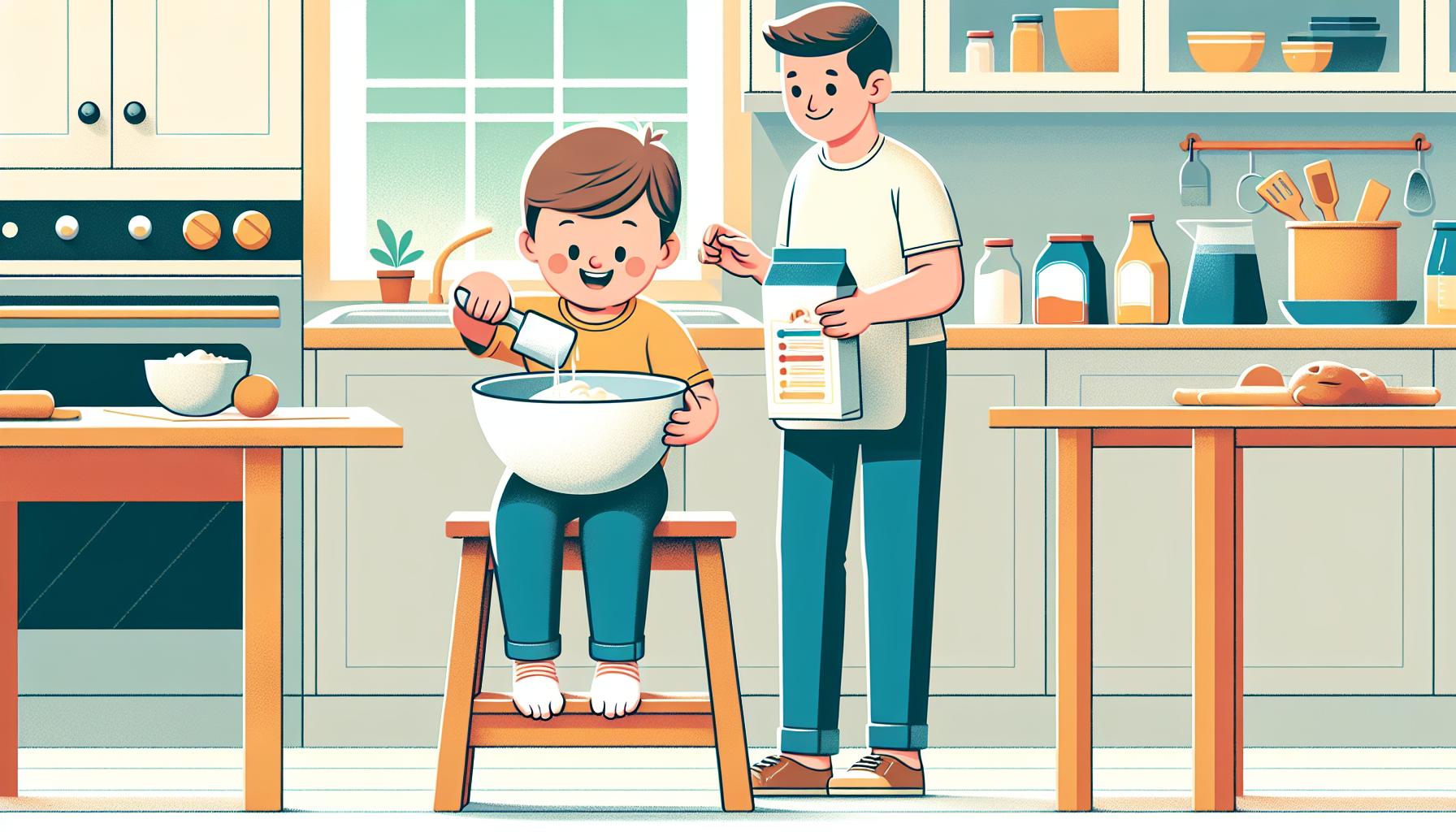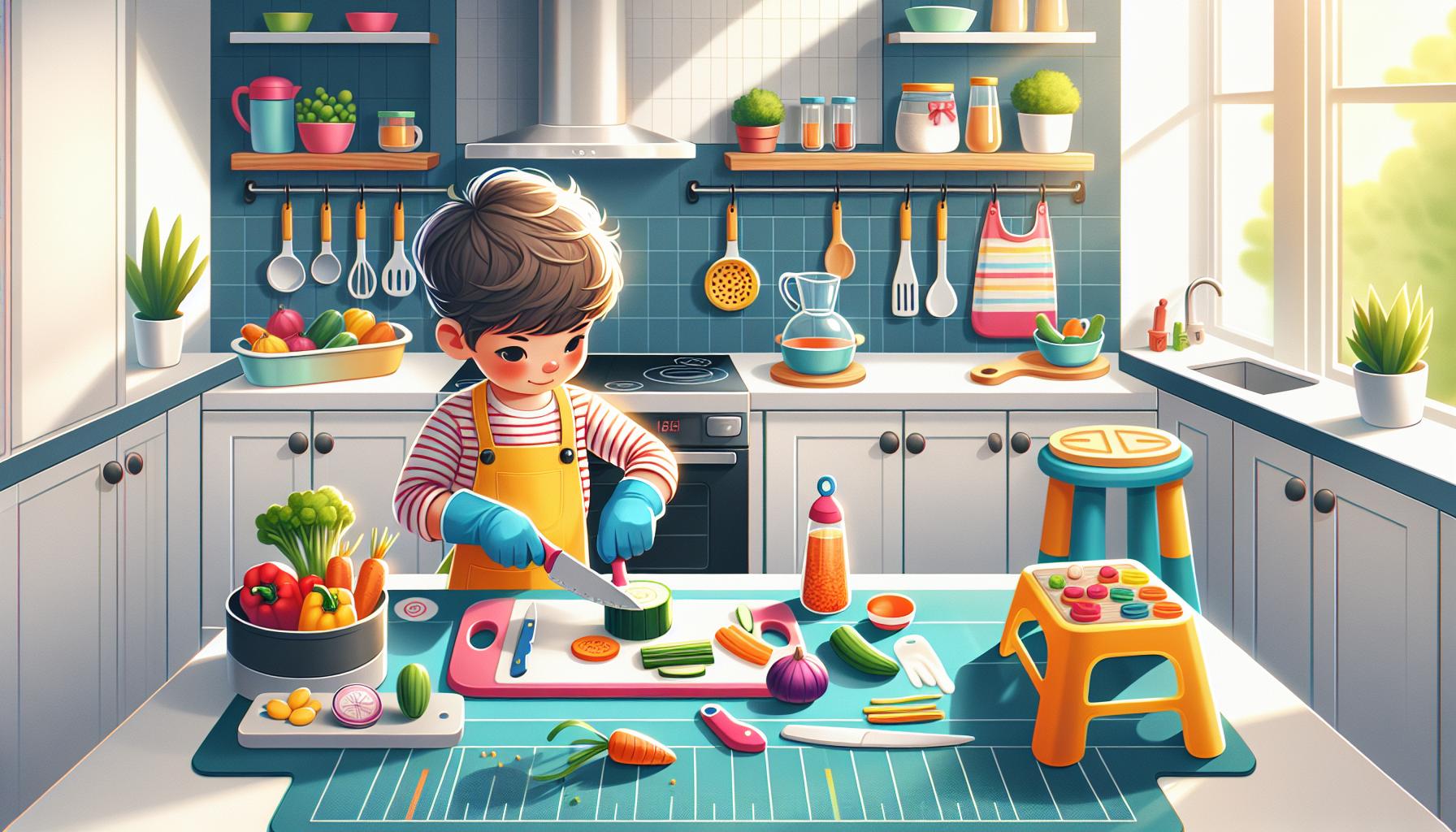
Teaching kids to cook does more than fill their stomachs – it builds confidence, creativity and valuable life skills. We’ve seen how children light up when they create their first successful dish, and we believe every parent can bring that joy to their kitchen. Getting started might feel overwhelming, but with the right approach, it’s easier than you think.
We understand the concerns about safety and mess that come with cooking alongside children. But what if we told you that these kitchen adventures could improve math skills, boost self-esteem, and even encourage picky eaters to try new foods? From measuring ingredients to following recipes, cooking offers countless opportunities for learning and growth.
Key Takeaways
- Teaching kids to cook builds essential life skills including math, reading comprehension, and critical thinking while boosting their confidence and self-esteem
- Age-appropriate tasks range from simple mixing and pouring for toddlers to using basic kitchen tools and following recipes for school-age children
- Proper kitchen safety, including hand washing, food temperature monitoring, and safe tool handling, creates a foundation for confident cooking experiences
- Creating an organized, kid-friendly kitchen space with accessible tools, clear labeling, and designated work zones promotes independence and safety
- Starting with simple recipes like no-bake treats and basic baking projects helps children develop fundamental cooking skills while keeping them engaged and motivated
Benefits of Teaching Kids to Cook
Teaching kids to cook creates meaningful learning opportunities that extend far beyond the kitchen. Here’s how cooking empowers children with essential skills for life.
Building Life Skills and Confidence
Cooking activities strengthen a child’s motor skills through measuring ingredients, stirring mixtures, and handling kitchen tools. Kids learn practical math by doubling recipes, dividing portions, and converting measurements. In the kitchen, children practice:
- Reading recipes enhances comprehension skills
- Following step-by-step instructions builds sequential thinking
- Making decisions about ingredients develops critical thinking
- Working together promotes teamwork skills
- Cleaning up teaches responsibility
Success in creating dishes boosts children’s self-esteem. Each completed recipe gives them a sense of achievement they can share with family members.
Developing Healthy Eating Habits
Kitchen experiences transform children’s relationship with food in positive ways. Kids who cook display:
- Greater willingness to try new ingredients like quinoa, kale, or chickpeas
- Better understanding of nutrition basics through hands-on learning
- Increased interest in where food comes from
- Pride in making healthy choices independently
- Appreciation for fresh whole foods over processed options
Direct involvement in meal preparation helps children recognize the effort that goes into cooking. They learn to value homemade food while developing skills to make nutritious choices throughout life.
| Skill Area | Benefits |
|---|---|
| Motor Skills | Chopping, mixing, measuring |
| Math | Fractions, multiplication, timing |
| Reading | Recipe comprehension, sequencing |
| Social | Communication, cooperation, sharing |
| Health | Nutrition knowledge, food safety |
Age-Appropriate Kitchen Tasks

Kitchen activities adapt to each developmental stage, allowing children to participate safely while building skills. Here’s how to match tasks to different age groups:
Tasks for Toddlers (2-3 Years)
Toddlers excel at simple, supervised kitchen activities that develop motor skills. They can:
- Pour pre-measured ingredients into bowls
- Wash fruits and vegetables in a colander
- Tear lettuce or herbs into pieces
- Mix ingredients with a wooden spoon
- Help wipe tables with a damp cloth
- Place toppings on pizzas or sandwiches
- Use cookie cutters with soft dough
Tasks for Preschoolers (4-5 Years)
Preschoolers show increased coordination and understanding of basic kitchen concepts. Their capabilities include:
- Crack eggs into a separate bowl
- Measure dry ingredients with cups and spoons
- Knead and shape dough
- Spread butter or soft spreads
- Cut soft fruits with a plastic knife
- Arrange ingredients on a plate
- Help load the dishwasher
- Gather ingredients from low cabinets
- Mash soft fruits or vegetables
Tasks for School-Age Kids (6-12 Years)
School-age children master more complex kitchen skills under supervision:
- Read and follow simple recipes
- Use a vegetable peeler
- Open cans with a can opener
- Grate cheese or vegetables
- Beat eggs with a whisk
- Measure liquid ingredients
- Use a microwave safely
- Pack their own lunches
- Help plan weekly meals
- Set timers and check temperatures
Each age group builds on previous skills while adding new ones. Consider posting a chart of approved tasks in the kitchen as a quick reference guide for both kids and adults.
| Age Group | Safety Equipment Needed | Supervision Level |
|---|---|---|
| 2-3 years | Non-slip stool, plastic tools | Constant supervision |
| 4-5 years | Child-safe knives, apron | Direct supervision |
| 6-12 years | Heat-proof gloves, proper utensils | Periodic checking |
Essential Kitchen Safety Rules

Teaching kids kitchen safety creates the foundation for confident cooking experiences. Here’s what parents need to know about keeping children safe while they explore culinary activities.
Basic Food Safety Guidelines
- Wash hands with soap for 20 seconds before touching food items or cooking tools
- Store raw meats on the bottom shelf of the refrigerator at 40°F or below
- Use separate cutting boards for produce and raw meats
- Clean all fruits and vegetables thoroughly under running water
- Check food temperatures with a meat thermometer
| Safe Minimum Internal Temperatures |
|---|
| Ground Meat: 160°F |
| Poultry: 165°F |
| Fish: 145°F |
| Pork: 145°F |
- Start with child-safe tools: plastic knives, safety scissors, measuring cups
- Demonstrate proper knife grip: pinch the blade near the handle with thumb and forefinger
- Keep knife tips pointing down and away from the body
- Hold pot handles away from the stove’s edge
- Use oven mitts or heat-resistant gloves for hot surfaces
- Keep electrical appliances away from water
- Store sharp tools in a designated drawer with safety locks
- Non-slip mats near sinks and prep areas
- Step stools with handrails
- Fire extinguisher within easy reach
- First aid kit in an accessible location
- Timer for tracking cooking duration
Creating a Kid-Friendly Kitchen Space
A kid-friendly kitchen promotes independence while maintaining safety standards. Setting up an accessible cooking environment encourages children to participate in meal preparation with confidence.
Organizing Tools and Ingredients
Child-appropriate kitchen tools belong in lower drawers or cabinets for easy access. Here’s how to organize effectively:
- Store frequently used tools (measuring cups, spoons, mixing bowls) at child height
- Label storage containers with pictures for pre-readers
- Create a designated snack drawer with parent-approved items
- Place heavy items in lower cabinets to prevent tipping
- Use clear containers to display ingredients at eye level
- Install magnetic strips at kid-height for lightweight metal utensils
- Position a sturdy step stool with railings at each work area
- Set up a prep station with:
- Non-slip cutting boards
- Easy-grip measuring tools
- Wide-base mixing bowls
- Clean-up supplies
- Create zones for different activities:
- Washing station with paper towels
- Mixing area with spill-catching mats
- Assembly space near ingredients
- Install task lighting over each workstation
- Keep a cleanup caddy stocked with:
- Child-sized cleaning tools
- Paper towels
- Non-toxic cleaning spray
- Hand soap
| Workstation Type | Essential Items | Height from Floor |
|---|---|---|
| Prep Area | Cutting board, tools | 24-26 inches |
| Mixing Station | Bowls, utensils | 28-30 inches |
| Washing Zone | Soap, towels | 30-32 inches |
Fun Recipes to Start With
Getting kids excited about cooking starts with simple recipes that create quick wins in the kitchen. Here’s a selection of beginner-friendly recipes that combine learning with delicious results.
No-Bake Recipes
No-bake recipes offer an ideal starting point for young chefs to build confidence without the complexities of using an oven. Kids can create tasty treats like energy balls, chocolate-dipped fruit kabobs or graham cracker houses. These recipes develop measuring skills, fine motor coordination and creative expression through hands-on activities. Pre-measured ingredients in clearly marked containers make the process smooth and enjoyable.
Simple Baking Projects
Basic baking activities introduce children to kitchen fundamentals while producing satisfying results. Classic recipes like sugar cookies, cupcakes and brownies teach essential skills:
- Measuring dry ingredients using cups and spoons
- Cracking eggs into separate bowls
- Mixing wet and dry ingredients properly
- Following step-by-step illustrated instructions
- Decorating finished treats with creative toppings
Pre-packaged ingredient kits streamline the process by:
| Feature | Benefit |
|---|---|
| Pre-measured portions | Reduces mess and waste |
| Individual packaging | Keeps ingredients fresh and organized |
| Picture-based instructions | Makes recipes accessible for all ages |
| High-quality ingredients | Ensures consistent results |
Kids practice math skills through measuring, reading comprehension through following recipes and artistic expression through decorating their creations. Starting with these foundational recipes builds skills for more advanced kitchen projects.
Conclusion
Empowering kids in the kitchen opens up a world of possibilities for their growth and development. We’ve seen how cooking activities build essential life skills while creating lasting memories and healthy habits that will serve them well into adulthood.
By creating a safe welcoming environment and providing age-appropriate tasks we’re setting our children up for success in the kitchen and beyond. The confidence they gain from mastering new skills and creating delicious dishes is truly priceless.
Let’s embrace the mess the giggles and the learning opportunities that come with cooking alongside our little chefs. Together we’re nurturing the next generation of confident capable cooks who’ll carry these valuable skills throughout their lives.
Frequently Asked Questions
At what age can children start helping in the kitchen?
Children can start participating in kitchen activities as early as 2 years old. Toddlers (2-3 years) can help with simple tasks like pouring pre-measured ingredients and washing fruits. As they grow, they can take on more complex tasks. Preschoolers (4-5 years) can crack eggs and measure ingredients, while school-age children (6-12 years) can read recipes and use basic kitchen tools.
What are the benefits of teaching kids to cook?
Teaching kids to cook develops multiple skills simultaneously. It enhances math abilities through measuring, improves reading comprehension through following recipes, builds motor skills, boosts self-confidence, and encourages healthy eating habits. Cooking also helps children understand nutrition better and makes them more willing to try new foods.
How can I ensure kitchen safety when cooking with kids?
Start by establishing clear safety rules, including proper hand washing and food handling. Use child-safe tools, ensure proper supervision, and create designated workstations. Keep pot handles turned inward, use non-slip mats, and have safety equipment like a fire extinguisher and first aid kit readily available. Post age-appropriate task charts as reference guides.
What are some easy recipes to start with?
Begin with no-bake recipes like energy balls and chocolate-dipped fruit kabobs. These simple recipes help build confidence and basic kitchen skills without the need for heat. As children progress, move on to basic baking projects like sugar cookies and cupcakes. Pre-packaged ingredient kits can be helpful for beginners.
How can I make my kitchen more kid-friendly?
Organize your kitchen to promote independence while maintaining safety. Store frequently used tools and ingredients at child height, label containers with pictures for pre-readers, and create designated snack drawers. Set up proper workstations with non-slip cutting boards and easy-grip measuring tools. Ensure clean-up supplies are easily accessible.
Will cooking with kids create too much mess?
While some mess is inevitable, proper preparation can minimize cleanup. Set clear guidelines, use pre-measured ingredients, establish designated prep areas, and teach cleaning as part of the cooking process. The educational benefits and quality time spent together far outweigh the temporary mess created.
How can cooking help with picky eating?
When children participate in meal preparation, they’re more likely to try new foods. Cooking creates a positive association with food exploration and gives kids a sense of ownership over their meals. They learn about different ingredients and develop a greater appreciation for various foods through hands-on experience.
What basic kitchen skills should children learn first?
Start with fundamental skills like proper hand washing, measuring ingredients, and basic mixing techniques. Teach them how to read recipes, identify common kitchen tools, and practice kitchen safety rules. As they master these basics, gradually introduce more complex skills like using kitchen tools and following multi-step recipes.

